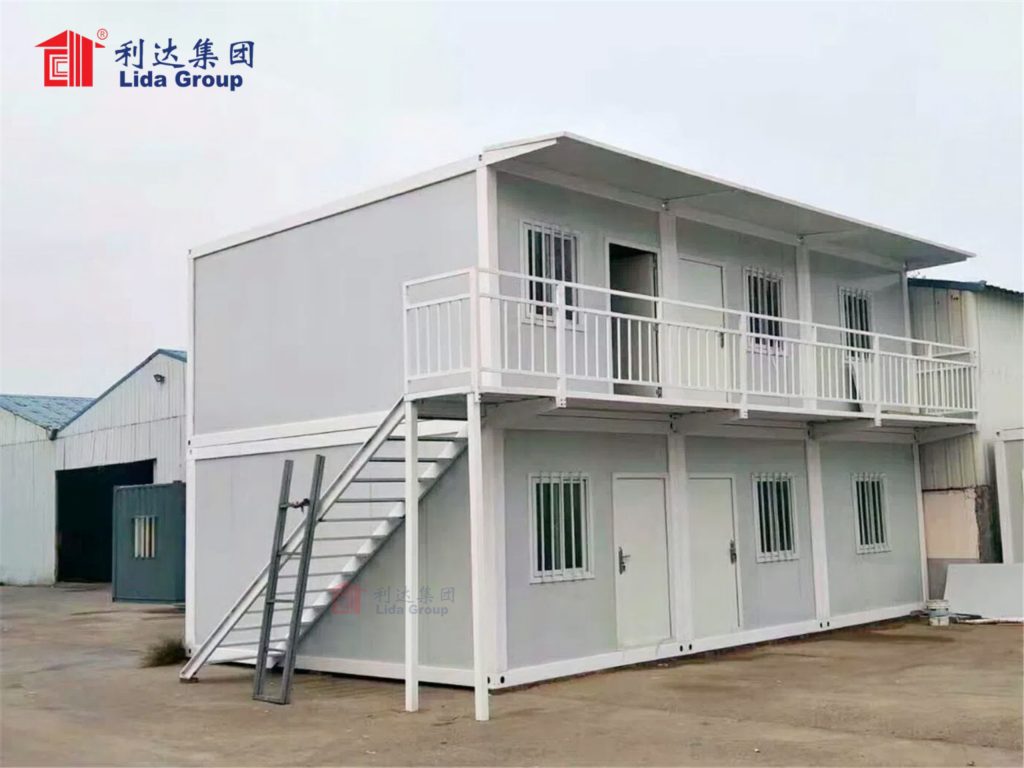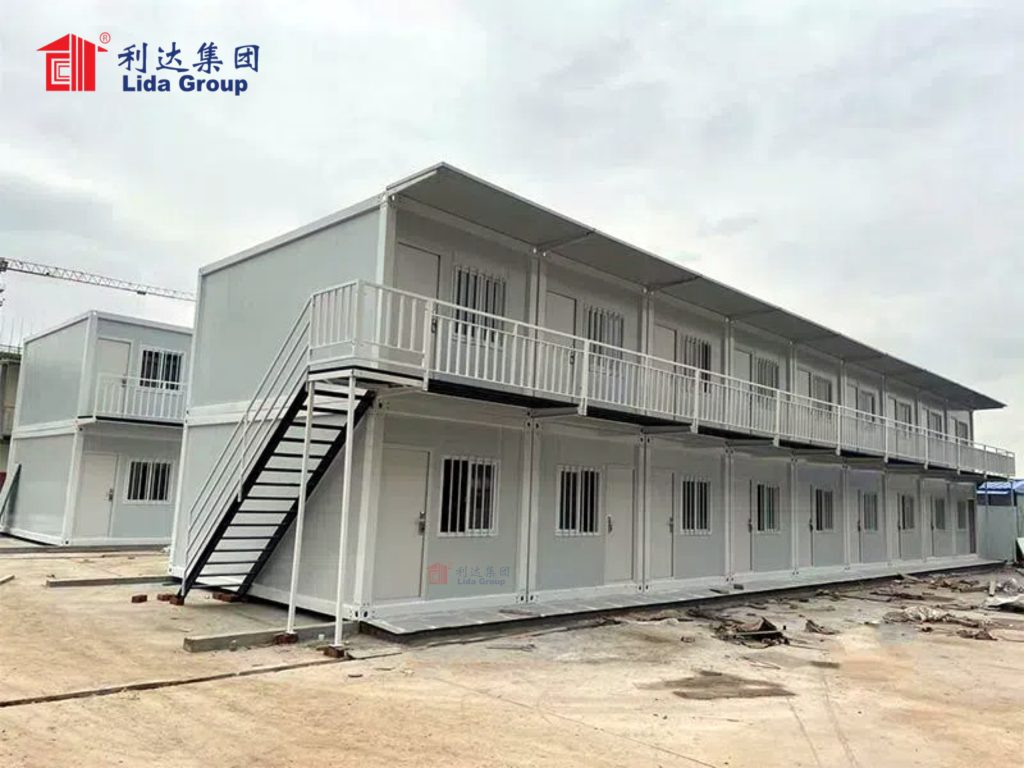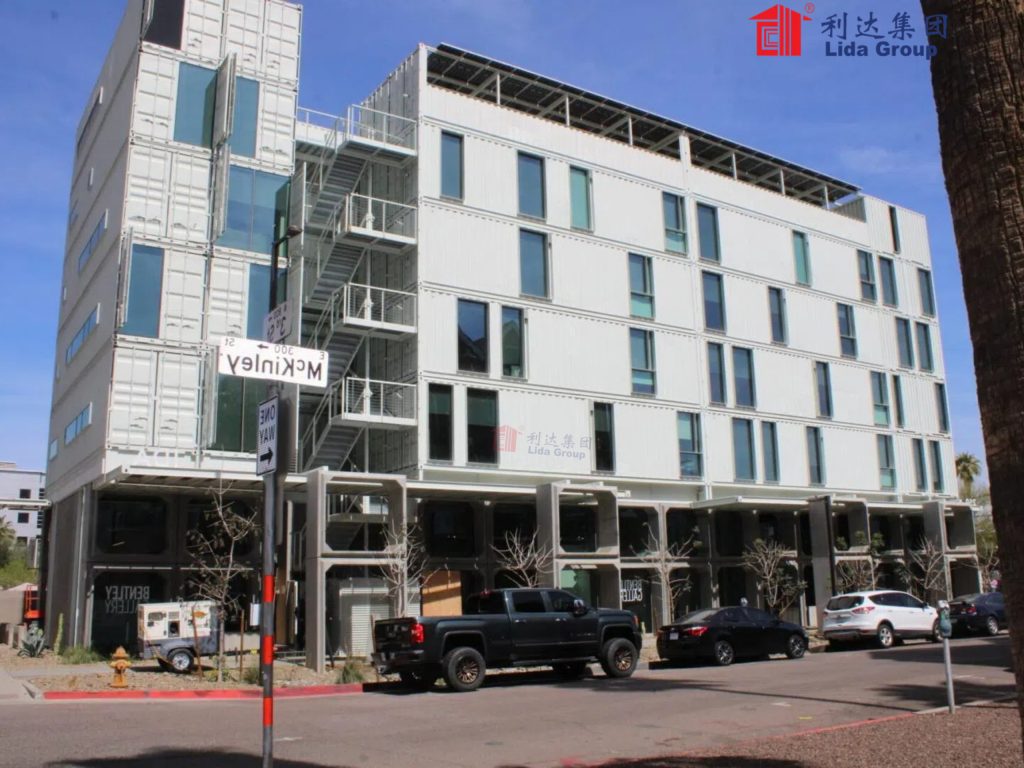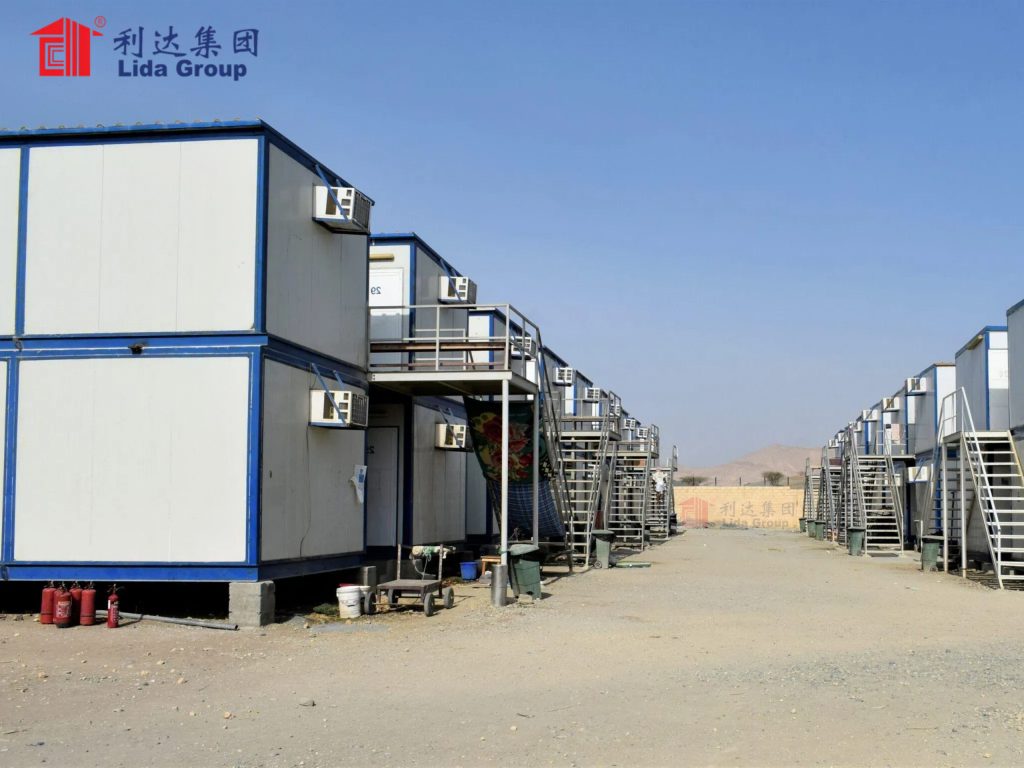How Lida Group’s Low Cost Prefab Construction is Making Mobile Modern Container House Living More Accessible
1. Introduction: The Global Housing Accessibility Crisis
Across the globe, access to safe, affordable, and flexible housing remains a critical challenge. The United Nations estimates that over 1.6 billion people lack adequate housing, with 100 million people currently homeless. For low-income families, young professionals, digital nomads, and disaster-displaced communities, the dream of stable housing is often out of reach due to skyrocketing real estate prices, slow construction timelines, and rigid housing models. Traditional homes—built with concrete, brick, and lumber—are not only expensive (costing \(150–\)300 per square foot in many regions) but also fixed in place, unable to adapt to changing lifestyles or urgent needs.
Mobile modern container houses, once a niche solution, have emerged as a promising alternative. Made from repurposed shipping containers, these homes offer inherent advantages: durability, portability, and potential affordability. However, early container housing often failed to deliver on accessibility—high modification costs, poor insulation, and limited design flexibility kept them out of reach for most. Lida Group, a global leader in low-cost prefabricated (prefab) construction, has transformed this landscape. By reimagining prefab techniques for container housing, Lida has created low-cost, mobile, and modern solutions that bring container living within reach of millions.
This article explores how Lida Group’s low-cost prefab construction is democratizing mobile modern container house living. It examines the key barriers to accessible container housing, the innovative prefab technologies Lida uses to reduce costs, and real-world case studies of how these homes are empowering diverse communities. Finally, it looks ahead to how Lida’s continued innovation will further expand access to flexible, affordable housing worldwide.
2. The Barriers to Accessible Mobile Container Housing
Before Lida Group’s intervention, mobile container housing faced three critical barriers that limited its accessibility: high costs, poor quality and comfort, and limited customization. These barriers prevented container homes from becoming a viable option for most people, confining them to niche uses like luxury tiny homes or temporary disaster shelters.
2.1 High Upfront and Modification Costs
Early container housing was surprisingly expensive, despite the low cost of raw shipping containers (which typically cost \(1,500–\)3,000 for a used 20-foot unit). The primary cost driver was on-site modification: cutting windows and doors, installing insulation, wiring for electricity, and adding plumbing required skilled labor and custom materials. A 20-foot container home modified on-site could cost \(30,000–\)50,000—far beyond the budget of low-income families or young professionals.
Transportation costs added to the burden. Shipping a modified container to remote areas (where affordable housing is most needed) often cost \(5,000–\)10,000, further inflating the total price. For example, a family in rural Kenya looking to buy a modified container home would face total costs of \(40,000–\)60,000—equivalent to 10–15 years of average income in the region.
2.2 Poor Quality and Comfort
Many early container homes sacrificed quality and comfort to cut costs. Insulation was minimal (often just fiberglass batts), leading to extreme indoor temperatures—sweltering in summer and freezing in winter. Flooring was often unfinished, and bathrooms were cramped or non-existent. These homes felt more like “temporary shelters” than permanent living spaces, deterring most people from choosing them.
Durability was also a concern. Improper modification (e.g., cutting steel beams without reinforcement) weakened the container’s structure, making it vulnerable to weather damage or collapse. In coastal areas, uncoated steel containers rusted quickly, requiring expensive maintenance or replacement within 5–10 years.
2.3 Limited Customization and Flexibility
Early container homes offered little customization. Most were one-size-fits-all designs, with fixed layouts that didn’t accommodate diverse needs—for example, a family of four needed more space than a single digital nomad, but there were few options to adjust size or features. This lack of flexibility meant that container homes often didn’t fit the unique lifestyles of potential users, reducing their appeal.
Mobility, while a selling point, was also limited. Many modified containers required permanent foundations or heavy equipment to relocate, making them less “mobile” than advertised. For digital nomads or seasonal workers who needed to move frequently, this lack of true portability was a major drawback.
3. Lida Group’s Low-Cost Prefab Construction: Breaking Down Barriers
Lida Group’s low-cost prefab construction addresses the barriers to accessible container housing through three core innovations: factory-based mass production, standardized yet customizable modules, and local manufacturing networks. These innovations reduce costs by up to 50% compared to early container homes, while improving quality, comfort, and flexibility.
3.1 Factory-Based Mass Production: Cutting Costs Through Efficiency
The biggest driver of Lida’s low costs is factory-based mass production. Unlike early container homes, which relied on costly on-site modification, Lida manufactures nearly all components in controlled factory environments. This approach delivers three key cost-saving benefits:
- Economies of Scale: By producing hundreds of container modules monthly, Lida negotiates lower prices for materials (e.g., insulation, steel brackets, fixtures) and reduces per-unit labor costs. For example, Lida sources insulation in bulk for $0.50 per square foot—half the cost of retail prices.
- Precision and Waste Reduction: Factory production uses computer-aided design (CAD) and automated machinery (e.g., CNC cutters, robotic welders) to ensure precise cuts and minimal waste. On-site construction typically wastes 15–20% of materials; Lida’s factories waste less than 5%, reducing material costs significantly.
- Faster Construction: Factory production allows parallel work—while one team modifies containers, another installs insulation, and a third adds fixtures. A 20-foot container home can be fully manufactured in 5–7 days, compared to 2–3 weeks for on-site modification. Faster production reduces labor costs and allows Lida to serve more customers at lower prices.
The result is a dramatic cost reduction: a basic 20-foot Lida container home costs just \(12,000–\)15,000, including insulation, basic plumbing, and electrical systems. This is 50–60% cheaper than early on-site modified container homes.
3.2 Standardized Modules with Customizable Features: Balancing Affordability and Flexibility
Lida avoids the “one-size-fits-all” problem of early container homes by using standardized modules with customizable add-ons. The company’s core product is a standardized 20-foot or 40-foot container module, which includes:
- Basic insulation (recycled polyester, R-value 25)
- A small kitchenette (mini-fridge, induction cooktop)
- A compact bathroom (composting toilet, shower)
- LED lighting and USB charging ports
- A fold-down bed or sofa bed
Customers can then add customizable features at low cost, such as:
- Extra insulation for cold climates (\(500–\)1,000)
- Solar panels for off-grid use (\(1,500–\)2,500)
- A rooftop deck (\(800–\)1,200)
- Additional modules (to expand to 40 feet or more, \(10,000–\)12,000 per module)
This “base + add-ons” model keeps upfront costs low while allowing customers to tailor their homes to their needs. For example, a digital nomad might choose the base 20-foot module with solar panels (\(13,500), while a family of three could opt for two connected 20-foot modules with extra insulation (\)25,000).
3.3 Local Manufacturing Networks: Reducing Transportation Costs
Transportation costs were a major barrier to accessible container housing, especially for customers in remote or low-income regions. Lida solves this by maintaining local manufacturing networks in 15 countries, including India, Kenya, Vietnam, and Mexico. These local factories:
- Source materials from nearby suppliers (e.g., steel in India, insulation in Mexico), reducing transportation costs for raw materials.
- Manufacture modules locally, eliminating the need to ship fully modified containers across oceans or continents.
- Employ local workers, reducing labor costs (compared to importing skilled labor) and supporting local economies.
For example, a customer in rural Kenya can purchase a 20-foot Lida container home for \(12,000—including local manufacturing and delivery—compared to \)40,000 for an imported modified container. Local manufacturing not only cuts costs but also ensures that Lida’s homes are adapted to regional needs (e.g., heat-resistant insulation in Kenya, flood-resistant foundations in Vietnam).
3.4 Quality Improvements at Low Cost
Lida’s low-cost prefab construction doesn’t mean sacrificing quality. The company integrates key quality features into its base modules, ensuring comfort and durability:
- Improved Insulation: Lida uses recycled polyester insulation (R-value 25) as standard, which is 2.5 times more effective than the fiberglass batts used in early container homes. This keeps interiors comfortable year-round, reducing energy costs for users.
- Structural Reinforcement: Automated machinery reinforces container walls and floors during manufacturing, ensuring that modifications (e.g., window cuts) don’t weaken the structure. Lida’s homes can withstand winds up to 150 km/h (category 4 hurricanes) and earthquakes up to magnitude 6.0.
- Corrosion Resistance: All steel components are coated with a low-cost, eco-friendly zinc-aluminum alloy that prevents rust—extending the home’s lifespan to 30–50 years, even in coastal areas.
- Sanitation Features: Composting toilets (included in all base modules) eliminate the need for expensive sewage infrastructure, making Lida’s homes suitable for remote areas. Low-flow showers and faucets also reduce water use, cutting utility costs for users.
These quality improvements ensure that Lida’s homes are not just affordable but also livable, durable, and sustainable.
4. Case Studies: Lida’s Low-Cost Container Homes Empowering Diverse Communities
Lida Group’s low-cost prefab container homes have made mobile modern living accessible to diverse communities—from low-income families in rural areas to digital nomads and disaster-displaced populations. The following case studies showcase how these homes are transforming lives by addressing specific accessibility challenges.
4.1 Case Study 1: Low-Income Families in Rural Kenya
Challenge: Rural Kenya faces a severe housing shortage, with 70% of families living in mud huts that leak during rains and offer little protection from pests or extreme weather. Traditional concrete homes cost \(25,000–\)35,000—far beyond the budget of most rural families, who earn an average of \(3,000–\)4,000 annually. These families needed affordable, durable homes that could withstand Kenya’s hot, dry climate and occasional floods.
Lida’s Solution: Lida opened a local factory in Nairobi in 2021, manufacturing 20-foot container homes tailored to rural Kenyan needs. The base module ($12,000) included:
- Heat-resistant insulation (recycled polyester, R-value 30) to keep interiors cool in 40°C+ temperatures.
- An elevated steel foundation to prevent flood damage during Kenya’s rainy season.
- A composting toilet and rainwater harvesting tank (200L) to address water and sanitation shortages.
- A small outdoor cooking nook to avoid indoor air pollution from open fires.
Lida also partnered with local microfinance institutions to offer low-interest loans (\(50–\)100 monthly repayments over 2–3 years), making the homes affordable for families with modest incomes.
Implementation and Results:
By 2023, Lida had sold 500 container homes to rural Kenyan families. Key outcomes included:
- Improved Living Conditions: 95% of families reported that their new homes were drier, cooler, and safer than their previous mud huts. Cases of malaria (spread by mosquitoes in mud huts) dropped by 60% in communities with Lida’s homes.
- Affordability: Monthly loan repayments were manageable for families, with 98% of borrowers making on-time payments. Many families used the money saved on repairs (mud huts require annual repairs costing \(500–\)1,000) to pay off loans faster.
- Community Impact: Lida’s Nairobi factory employed 100 local workers, many of whom were previously unemployed. The factory also trained 50 local contractors to assemble and maintain the homes, creating long-term jobs.
“Our Lida home changed everything,” said Mary Wambui, a mother of three who works as a small-scale farmer. “We no longer sleep on wet mats during rains, and my children can study at night with LED lights. The loan payments are small, and I don’t have to spend money on hut repairs anymore. This is the first time we’ve had a real home.”
4.2 Case Study 2: Digital Nomads in Southeast Asia
Challenge: Southeast Asia has become a hub for digital nomads, with over 3 million remote workers living in countries like Thailand, Vietnam, and Indonesia. However, finding affordable, flexible housing is a major challenge: monthly rent for a small apartment in popular cities like Chiang Mai (Thailand) or Bali (Indonesia) costs \(500–\)800, and long-term leases (6–12 months) restrict mobility. Digital nomads needed low-cost, mobile homes that could be relocated easily and equipped for remote work.
Lida’s Solution: Lida launched a “Digital Nomad Package” in 2022, based on its 20-foot container module, priced at $15,000. The package included:
A fold-down desk (converts to a dining table) and ergonomic chair for remote work.
High-speed internet wiring and a Wi-Fi router.
Solar panels (400W) and a battery (100Ah) for off-grid use in remote areas (e.g., beachfront lots in Bali).
Heavy-duty wheels and a hitch for towing by truck (enabling relocation every 1–2 months).
A small outdoor terrace with a foldable table and chairs for working outdoors.
Lida also partnered with local landowners in popular nomad destinations to offer “container-friendly” lots for rent (\(100–\)200 monthly), including access to water and basic utilities.
Implementation and Results:
By 2023, Lida had sold 300 Digital Nomad Packages to remote workers in Southeast Asia. Key outcomes included:
Cost Savings: Nomads reported saving \(3,000–\)6,000 annually compared to renting apartments. Many recouped the upfront cost of the container home within 2–3 years of use.
Mobility: 80% of nomads relocated their container homes at least 3 times in the first year, moving between cities or countries as needed. Setup at each new location took 1–2 hours, with no need for professional help.
Work-Life Balance: The dedicated workspace and outdoor terrace improved productivity, with 75% of nomads reporting higher work satisfaction compared to apartment living. The solar panels also allowed nomads to work in remote areas without reliable electricity.
“Lida’s container home gave me the freedom I needed,” said Mark Chen, a software developer from Canada living in Southeast Asia. “I can work from a beach in Bali one month and a mountain town in Thailand the next—all with my own comfortable space. The cost savings are a bonus, but the mobility is what makes it worth it.”
4.3 Case Study 3: Disaster-Displaced Communities in Bangladesh
Challenge: Bangladesh is one of the most disaster-prone countries in the world, with annual floods and cyclones displacing millions of people. After the 2022 Sylhet floods, over 2 million people were left homeless, living in temporary tents that offered little protection from the elements. The Bangladeshi government needed low-cost, fast-to-deploy housing that could serve as both temporary shelter and long-term homes for displaced families.
Lida’s Solution: Lida partnered with the Bangladeshi government and UN-Habitat to manufacture 1,000 container homes at its local factory in Dhaka. The homes were designed for disaster resilience and priced at \(10,000 each (subsidized by the government to \)5,000 for families). Key features included:
Elevated steel foundations (1.5 meters high) to withstand future floods.
Water-resistant insulation and sealed windows to prevent water damage.
A large storage compartment for food and emergency supplies.
A modular design that allowed 2–3 homes to be connected for larger families.
Lida’s factory produced 100 homes per week, with local teams assembling them on-site in flood-affected areas within 24 hours of delivery.
Implementation and Results:
By early 2023, all 1,000 homes were deployed to displaced families in Sylhet and Cox’s Bazar. Key outcomes included:
Rapid Shelter: The homes were deployed 3 times faster than traditional temporary shelters, providing families with safe housing within weeks of the floods.
Disaster Resilience: When minor floods hit Sylhet again in 2023, the elevated foundations kept all homes dry, while nearby tents were submerged. Families reported feeling “safe and secure” for the first time since the disaster.
Long-Term Use: 90% of families chose to keep the homes as permanent housing after rebuilding their communities. The modular design allowed them to expand the homes as their needs grew (e.g., adding a module for a
growing child).
- Community Recovery: The homes became anchors for community rebuilding. Families used the stable shelter as a base to restart small businesses (e.g., selling vegetables, sewing clothes), and local schools set up temporary classrooms in connected container modules—helping children return to education within months of the disaster.
“After the floods, we had nothing,” said Fatima Khatun, a mother of four who received a Lida container home. “The tent we lived in leaked, and my children were always sick. Now, we have a dry, safe home. I can even sell my sewing from the front porch. This home didn’t just shelter us—it helped us rebuild our lives.”
4.4 Case Study 4: Young Professionals in Urban India
Challenge: Urban India (e.g., Mumbai, Bangalore) faces a severe housing crisis for young professionals. Rental prices for small apartments in city centers often exceed \(300–\)400 monthly—40–50% of the average young professional’s salary. Many professionals are forced to live in overcrowded shared housing or commute 2–3 hours daily from affordable suburbs. They needed affordable, centrally located housing that offered privacy and flexibility (to move if they changed jobs).
Lida’s Solution: Lida launched a “Urban Studio” line of 15-foot container homes designed for urban living, manufactured at its Ahmedabad factory and deployed in container communities near public transit hubs in Mumbai and Bangalore. The base model cost \(10,000, with a monthly ownership plan (\)150–$200 monthly over 5 years) to reduce upfront costs. Key features included:
- Compact, space-saving design: A fold-down bed (stows away during the day), built-in storage, and a mini-kitchen with a induction cooktop.
- Soundproof insulation (to reduce urban noise pollution) and large windows for natural light.
- Access to shared amenities in the container community: A communal lounge, laundry facilities, and bike storage.
- Proximity to metro stations (within 5–10 minutes’ walk), reducing commute times.
Implementation and Results:
By 2023, Lida had launched three container communities in Mumbai and Bangalore, housing 250 young professionals. Key outcomes included:
- Affordability: Monthly ownership costs were 30–40% lower than renting a comparable apartment. Professionals reported saving \(150–\)200 monthly, which they used to pay off student loans or invest in their careers.
- Flexibility: 40% of residents moved to a different Lida container community (e.g., from Mumbai to Bangalore) when they changed jobs, with Lida handling the relocation for a small fee ($500). This flexibility eliminated the need to break rental leases or abandon furniture.
- Community and Well-Being: The shared amenities fostered a sense of community, with 80% of residents reporting that they had made friends in the container community. The reduced commute time also improved work-life balance, with residents spending 5–10 more hours weekly on hobbies or exercise.
“The Urban Studio changed how I live in Mumbai,” said Raj Patel, a 26-year-old software engineer. “I used to commute 2.5 hours each way to save on rent. Now, I live 10 minutes from work, have my own space, and still save money. It’s not just a home—it’s given me back my time.”
5. Market Feedback and Industry Impact
Lida Group’s low-cost prefab container homes have earned widespread acclaim from users, housing advocates, and industry experts. This feedback highlights how Lida’s solutions are not just making container living accessible but also reshaping the broader housing industry’s approach to affordability and flexibility.
5.1 User Testimonials
Across demographics, users consistently emphasize the transformative impact of Lida’s homes on their lives:
- Low-Income Families: “We never thought we’d own a home,” said a rural Kenyan mother. “The Lida container is dry, safe, and affordable. My children now sleep well at night, and I don’t have to worry about repairs anymore.”
- Digital Nomads: “Lida’s home gave me the freedom to work from anywhere,” said a Southeast Asia-based remote worker. “I save money on rent, and I can move whenever I want. It’s the perfect lifestyle for me.”
- Disaster Survivors: “The container home was our lifeline after the floods,” said a Bangladeshi resident. “It kept us safe, and now it’s our permanent home. We’re not just survivors—we’re rebuilding.”
- Young Professionals: “Lida’s Urban Studio made city living affordable,” said a Mumbai-based engineer. “I have my own space, a short commute, and I’m actually saving money. It’s changed my quality of life.”
5.2 Recognition from Housing Advocates and Governments
Lida’s work has been recognized by leading housing organizations and governments for its role in advancing affordable housing:
- UN-Habitat: “Lida Group is a critical partner in our mission to ensure adequate housing for all,” said Maimunah Mohd Sharif, former Executive Director of UN-Habitat. “Their low-cost container homes deliver on speed, affordability, and dignity—key to addressing global housing shortages.”
- Kenyan Ministry of Housing: “Lida’s local factory has revolutionized affordable housing in rural Kenya,” said a ministry official. “We’ve partnered with Lida to build 5,000 more homes over the next 3 years, as part of our national housing plan.”
- Indian Ministry of Urban Development: “Lida’s Urban Studio addresses the unique needs of young urban professionals,” said a ministry representative. “We’re encouraging more cities to adopt this model to ease the urban housing crisis.”
5.3 Industry Impact
Lida’s low-cost prefab construction has had a transformative effect on the container housing and broader prefab industry:
- Lowering Industry Price Points: Before Lida, the average cost of a container home was \(30,000–\)50,000. Lida’s \(10,000–\)15,000 base models have forced competitors to reduce prices by 30–40%, making container living accessible to more people.
- Mainstreaming Prefab Container Housing: Lida’s focus on quality, customization, and local manufacturing has helped container housing move beyond niche use (e.g., luxury tiny homes) to become a mainstream affordable housing option. A 2023 industry report found that container housing demand grew by 75% globally, with Lida cited as the key driver.
- Inspiring Policy Change: Lida’s projects have influenced housing policies in countries like Kenya, Bangladesh, and India. For example, Kenya now offers tax incentives for local prefab container manufacturers, while Bangladesh has included container homes in its national disaster response plan.
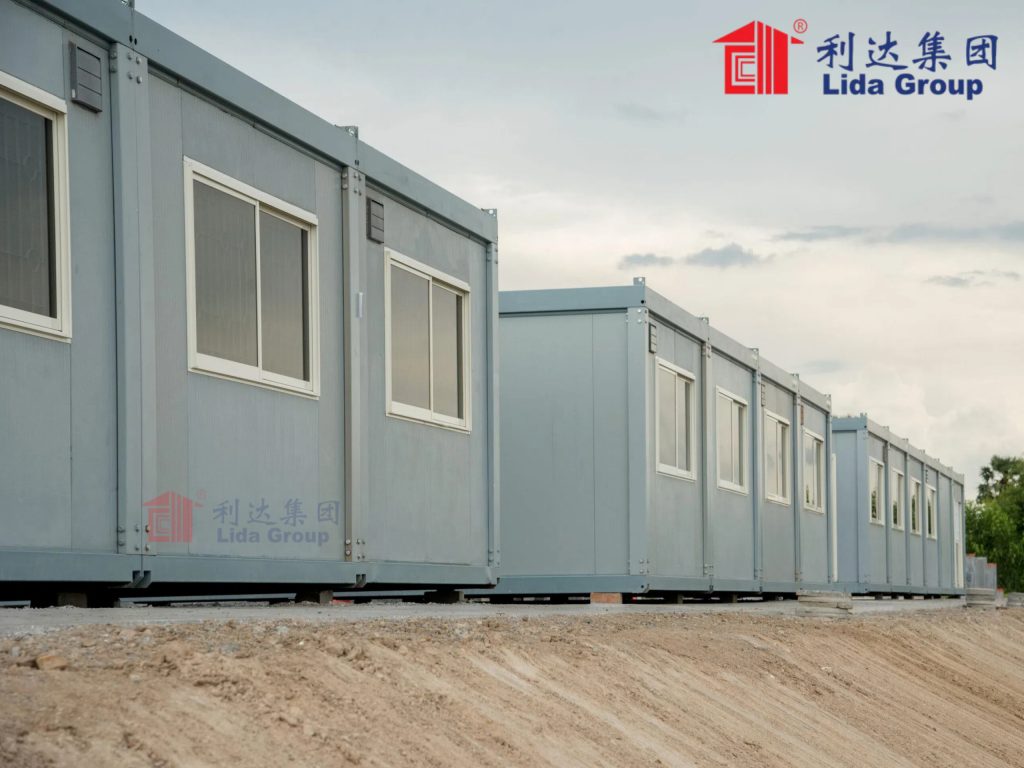
6. Future Plans: Expanding Access to Mobile Modern Container Living
Lida Group is committed to further expanding access to its low-cost prefab container homes, with plans to address emerging needs and reach more underserved communities. These initiatives will ensure that Lida continues to lead the way in making mobile modern container living accessible to all.
6.1 Even Lower-Cost Models for Extreme Poverty
Lida is developing an entry-level container home model priced at \(8,000, targeting communities in extreme poverty (e.g., rural parts of Ethiopia, Malawi). The model will include essential features only—basic insulation, a composting toilet, and LED lighting—but will retain Lida’s quality standards (structural reinforcement, corrosion resistance). To reduce costs further, Lida will partner with NGOs to subsidize the homes, making them available for \)3,000–$5,000 for low-income families. The first pilot projects will launch in Ethiopia in 2025.
6.2 Smart Home Features at Low Cost
To meet the needs of tech-savvy users (e.g., digital nomads, young professionals), Lida is integrating affordable smart home features into its base models. These features will include:
- A basic smart thermostat (controllable via mobile app, \(50–\)75) to optimize energy use.
- Wireless security cameras (\(100–\)150) for safety, especially in urban areas.
- A low-cost energy monitoring system (\(30–\)50) to help users track and reduce utility bills.
These features will be added to the base model for an extra \(200–\)300, making smart living accessible without significantly increasing costs.
6.3 Expansion to More Emerging Markets
Lida plans to expand its local manufacturing network to 25 countries by 2027, focusing on regions with severe housing shortages, such as:
- Sub-Saharan Africa: New factories in Ethiopia, Nigeria, and Tanzania will serve rural and urban communities, with a focus on affordable housing and disaster relief.
- Central America: A factory in Guatemala will produce container homes for families affected by hurricanes and rural poverty.
- Southeast Asia: Factories in Cambodia and Myanmar will address housing needs in fast-urbanizing cities and remote rural areas.
Local manufacturing will ensure that homes are adapted to regional climates (e.g., hurricane-resistant designs in Central America, heat-resistant insulation in Africa) and priced for local incomes.
6.4 Community-Focused Developments
Lida is moving beyond individual homes to create container communities with shared amenities, designed to foster social connection and improve quality of life. These communities will include:
- Shared green spaces and community gardens (to promote food security and well-being).
- On-site schools or childcare centers (for families in rural areas).
- Small commercial spaces (e.g., a community store, café) to support local entrepreneurs.
The first community-focused development will launch in Kenya in 2025, with 200 container homes and shared amenities, funded in part by a grant from the Bill & Melinda Gates Foundation.
7. Conclusion
Lida Group’s low-cost prefab construction has transformed mobile modern container house living from a niche luxury to an accessible reality for millions. By addressing the core barriers of high costs, poor quality, and limited flexibility, Lida has proven that container homes can be affordable, comfortable, and tailored to diverse needs—whether for a low-income family in rural Kenya, a digital nomad in Southeast Asia, a disaster survivor in Bangladesh, or a young professional in urban India.
At the heart of Lida’s success is its commitment to innovation that prioritizes people. Factory-based mass production cuts costs without sacrificing quality; local manufacturing networks reduce transportation expenses and support local economies; and the “base + add-ons” model balances affordability with customization. These innovations have not just made container living accessible—they have restored dignity to families who once had no safe place to call home, given freedom to professionals trapped in costly rentals, and provided hope to communities rebuilding after disaster.
The impact of Lida’s work extends beyond individual users. It has reshaped the housing industry, lowering price points and mainstreaming container housing as a viable solution for global housing shortages. It has influenced policy, with governments adopting container homes into national housing and disaster response plans. And it has inspired a new vision of housing—one that is flexible, sustainable, and inclusive.
As Lida expands to more markets, develops even lower-cost models, and builds community-focused developments, its mission remains clear: to ensure that everyone, regardless of income or circumstance, has access to a safe, affordable, and mobile home. In a world where housing inequality continues to grow, Lida Group’s low-cost prefab container homes are not just a construction solution—they are a step toward a more equitable future.
For anyone who has ever dreamed of stable housing but been priced out, Lida’s work offers a powerful message: home doesn’t have to be expensive, fixed, or out of reach. With innovation, empathy, and a focus on accessibility, mobile modern container living can be a reality for all.
